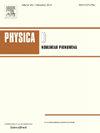Existence and stability of soliton-based frequency combs in the Lugiato–Lefever equation
IF 2.9
3区 数学
Q1 MATHEMATICS, APPLIED
引用次数: 0
Abstract
Kerr frequency combs are optical signals consisting of a multitude of equally spaced excited modes in frequency space. They are generated in optical microresonators pumped by a continuous-wave laser. It has been experimentally observed that the interplay of Kerr nonlinearity and dispersion in the microresonator can lead to a stable optical signal consisting of a periodic sequence of highly localized ultra-short pulses, resulting in broad frequency spectrum. The discovery that stable broadband frequency combs can be generated in microresonators has unlocked a wide range of promising applications, particularly in optical communications, spectroscopy and frequency metrology. In its simplest form, the physics in the microresonator is modeled by the Lugiato–Lefever equation, a damped nonlinear Schrödinger equation with forcing. In this paper, we rigorously demonstrate that the Lugiato–Lefever equation indeed supports arbitrarily broad Kerr frequency combs by proving the first existence and stability results of periodic solutions consisting of any number of well-separated, strongly localized and highly nonlinear pulses on a single periodicity interval. We realize these periodic multi-soliton solutions as concatenations of individual bright cavity solitons by phrasing the problem as a reversible dynamical system and employing results from homoclinic bifurcation theory. The spatial dynamics formulation enables us to harness general results, based on Evans-function techniques and Lin’s method, to rigorously establish diffusive spectral stability. This, in turn, yields nonlinear stability of the periodic multi-soliton solutions against localized and subharmonic perturbations.
Lugiato-Lefever方程中基于孤子的频率梳的存在性和稳定性
克尔频率梳是在频率空间中由许多等间隔的激发模组成的光信号。它们在连续波激光泵浦的光学微谐振腔中产生。实验观察到,克尔非线性和色散在微谐振腔中的相互作用可以产生稳定的光信号,该信号由高度局域化的超短脉冲周期序列组成,从而产生宽频谱。稳定的宽带频率梳可以在微谐振器中产生,这一发现开启了广泛的有前途的应用,特别是在光通信、光谱学和频率计量方面。在其最简单的形式中,微谐振器中的物理用Lugiato-Lefever方程来建模,这是一个带强迫的阻尼非线性Schrödinger方程。本文通过证明在单个周期区间上由任意数量的分离良好的、强局域的和高度非线性的脉冲组成的周期解的第一存在性和稳定性结果,严格地证明了Lugiato-Lefever方程确实支持任意宽的Kerr频率梳。通过将问题描述为可逆动力系统,并利用同斜分岔理论的结果,我们将这些周期多孤子解实现为单个亮腔孤子的串联。空间动力学公式使我们能够利用基于evans函数技术和Lin方法的一般结果,严格地建立扩散谱稳定性。这反过来又产生了周期多孤子解在局域扰动和次谐波扰动下的非线性稳定性。
本文章由计算机程序翻译,如有差异,请以英文原文为准。
求助全文
约1分钟内获得全文
求助全文
来源期刊

Physica D: Nonlinear Phenomena
物理-物理:数学物理
CiteScore
7.30
自引率
7.50%
发文量
213
审稿时长
65 days
期刊介绍:
Physica D (Nonlinear Phenomena) publishes research and review articles reporting on experimental and theoretical works, techniques and ideas that advance the understanding of nonlinear phenomena. Topics encompass wave motion in physical, chemical and biological systems; physical or biological phenomena governed by nonlinear field equations, including hydrodynamics and turbulence; pattern formation and cooperative phenomena; instability, bifurcations, chaos, and space-time disorder; integrable/Hamiltonian systems; asymptotic analysis and, more generally, mathematical methods for nonlinear systems.
 求助内容:
求助内容: 应助结果提醒方式:
应助结果提醒方式:


